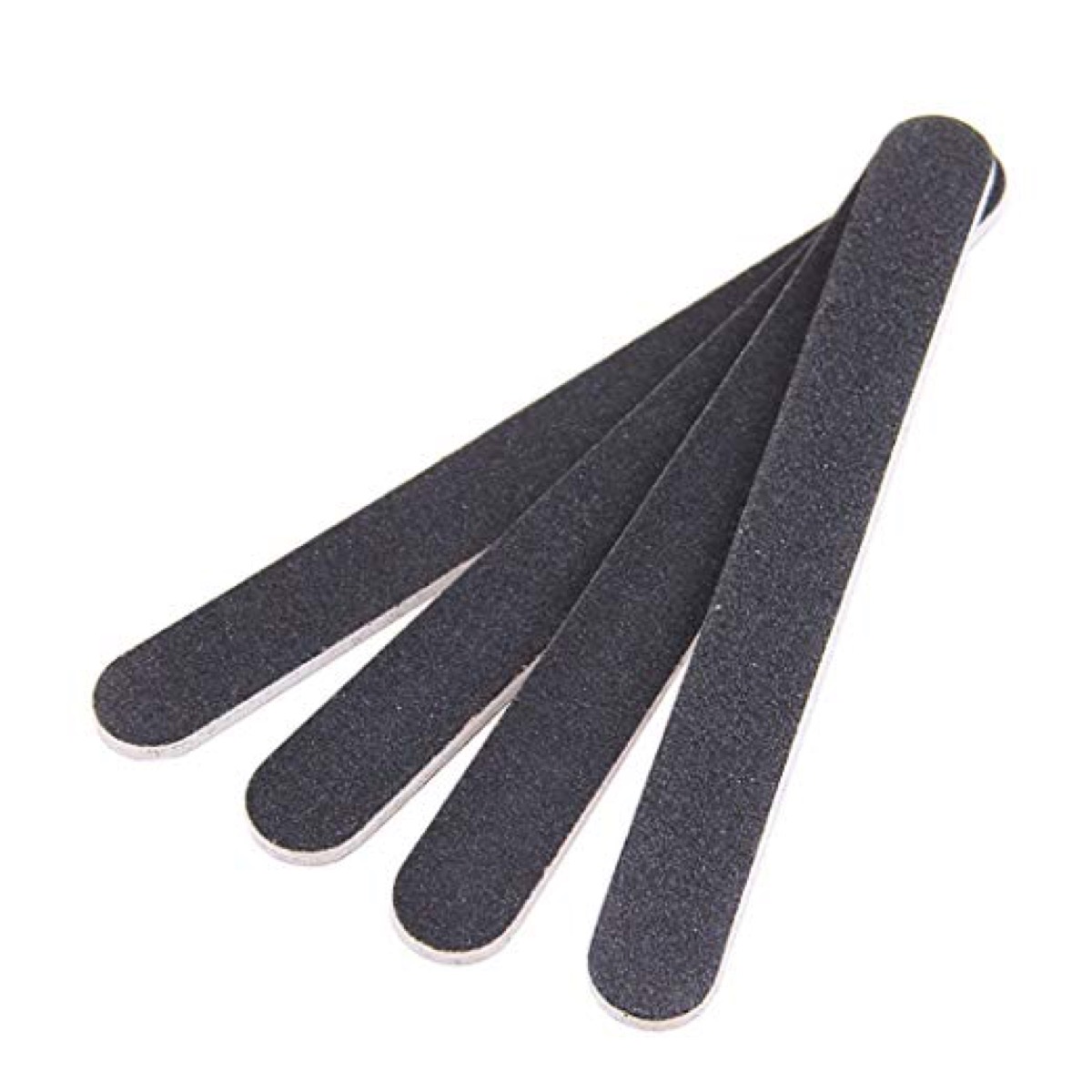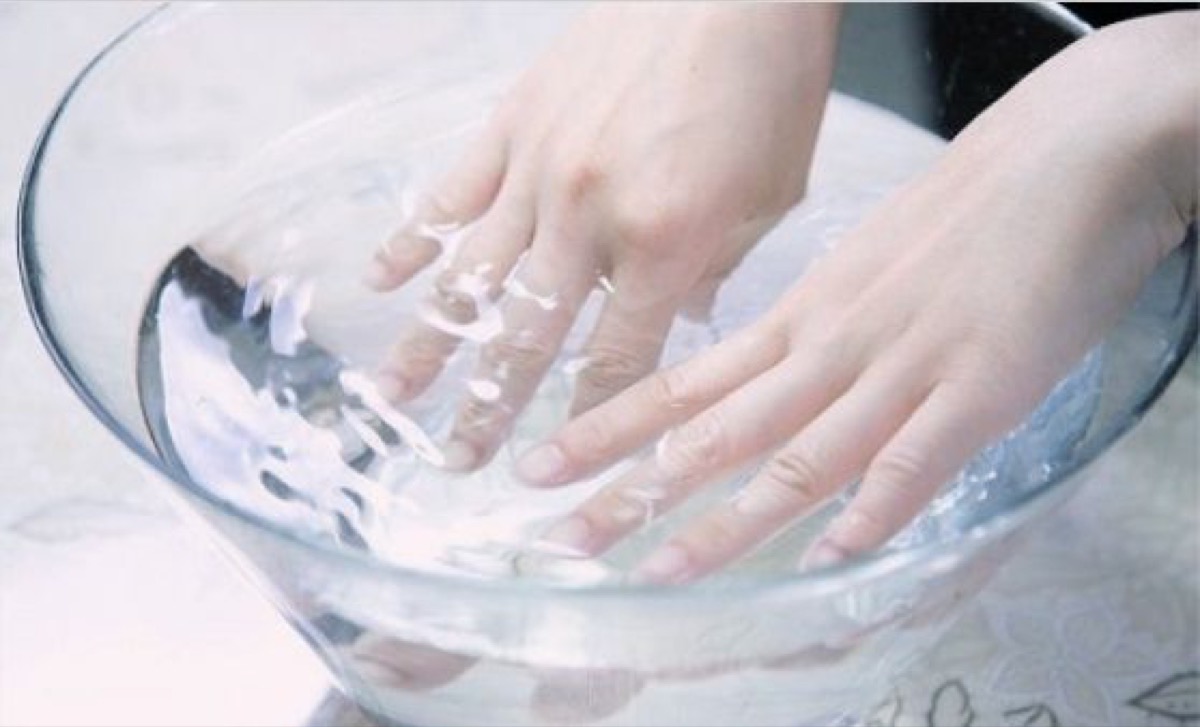23 Secrets Your Nail Salon Technician Wishes You Knew

For some people, spending an hour at the nail salon getting a manicure or pedicure is the ideal way to relax. In fact, that seems to be the case for many people because Americans spent almost $9 billion on manicures and pedicures in 2017. Part of the reason why so many of us spend that money getting our nails filed, buffed, and painted by experts is because we don’t really know much about nail care ourselves. It’s something we’d much rather leave to the pros.
However, if you want to make the most out of your next visit to the nail salon, it’s a good idea to get a little education. Whether it’s for your physical health or their emotional well-being, there are many things your nail technician is probably keeping to themselves. From the real way you should care for your cuticles to the items you should be bringing yourself, here are the nail salon secrets you should know.
1
Don’t let anyone shave your calluses.

Especially with a credo blade. If a salon offers to shave your callus using this tool, it’s time to head to a new salon. The credo blade—which is illegal in New York state and in many others, as well—has a history of tearing up customers’ feet to the point of life-changing disasters. Last year, for example, one woman in North Carolina almost lost her leg due to a strep infection she got from a pedicure with a credo blade.
In addition to putting you at risk for all sorts of infections, podiatrists caution that callus shaving is counterproductive. Unless you change your footwear, those calluses are going to grow back. “The most that I think is appropriate is just filing some of the calluses. And that should be done gently,” Dr. Jacqueline Sutera of City Podiatrists in New York told National Post.
2
Don’t let anyone cut your cuticles either.

“Many salon visitors do not realize that the cutting of cuticles is harmful to your nails,” says Dave Crisalli, founder and CEO of innovative nail boutique PROSE.
In fact, that skin is there for a purpose. “Cuticles protect your nails and the surrounding skin from infection,” explains the American Academy of Dermatology. “When you trim or cut your cuticles, it’s easier for bacteria and other germs to get inside your body and cause an infection.”
Next time, ask your technician to simply push your cuticles back, leaving the skin intact.
3
Don’t trust a nail file you can’t take home.

No two people should use the same nail file. However, at far too many salons, a file may be used repeatedly to cut costs. “It’s unsanitary to use a nail file on more than one client,” celebrity manicurist Elle Gerstein told Refinery29. “If the person before you had a fungus, it can spread to you.”
At his boutique, Crisalli gives guests their nail files to take home with them, which ensures that they are never re-used. If you notice your nail salon is secretly using nail files again and again, you should point it out to them… or maybe find a new salon.
4
But you should always use a nail file, not clippers.

Despite the prevalence of nail clippers at every drug store, you should be using a nail file instead. A file gives you added control and clippers are more likely to cause breakage. “An emory board is how you get even nails, shaped to perfection,” manicurist Deborah Lippmann told GQ.
If you must clip, make sure to soak your nails in water beforehand, making them less brittle and liable to crack.
5
Always bring your own flip flops.

Another item that isn’t hygienic to share? Footwear. “It is recommended that guests bring their own flip flops to cut down on exposure to harmful bacteria,” Crisalli says.
Unfortunately, some salons do not offer a sanitized set of slippers during your pedicure, so it’s crucial to bring your own.
6
You should also bring your own polish.

While they won’t openly admit it, some nail salons secretly dilute their polish. Not only is it not sanitary, but it also means you’re being taken advantage of.
“Some salons will dilute with nail polish remover nail polish bottles that have become clumpy from old age or from too much air exposure,” Jin Soon Choi, owner of Jinsoon Natural Hand and Foot Spas in New York City, told TotalBeauty.com.
That’s why you should always come with your own polish handy. Sure, it’s not quite as exciting as picking something out once you arrive, but it will save you money and keep you safe. You can’t beat that.
7
Most salons do not have the proper sanitization technology.

When it comes to sterilization, an autoclave is the be-all and end-all. This machine, which uses heat and high pressure to kill microorganisms, is widely used in science labs to clean equipment and decontaminate waste.
But only a few states—like New York and Texas—require that nail salons use an autoclave. And because the machinery is expensive, salon owners are unlikely to purchase one if they don’t have to. To be sure the tools your technician is using have been properly cleaned, ask the salon how they sterilize them. If it’s not with an autoclave, it’s not good enough.
7
If a salon is inexpensive, there’s probably a reason.

As Dr. Robert Spalding, author of Death By Pedicure, told U.S. News, “About 75 percent of salons in the U.S. don’t follow state protocol for disinfection.” Unfortunately, many technicians are under pressure from employers and are unlikely to turn away business by revealing these unsafe practices. That means it’s up to you to stay safe and ask the important questions.
9
Beware of hidden toxic ingredients.

“Visitors to nail salons should always avoid potentially toxic ingredients that could be lurking in nail products,” says Crisalli, citing formaldehyde, formaldehyde resin, and toulene, as examples.
A 2015 study published in Environment International found that nearly half of all nail polishes contain triphenyl phosphate, a chemical that can affect hormone regulation, metabolism, and reproductive systems. “It is very troubling that nail polish being marketed to women and teenage girls contains a suspected endocrine disruptor,” said Johanna Congleton, a co-author of the study. “It is even more troubling to learn that their bodies absorb this chemical relatively quickly after they apply a coat of polish.”
To avoid all chemicals, Crisalli urges using paraben-free nail products, which don’t contain “the most common chemicals known to be harmful to the nails and surrounding skin,” he explains.
10
UV lamps aren’t harmless.

If you’ve ever wondered whether those bright blue UV lamps used during your gel manicure are giving you cancer, the answer is: It’s possible.
According to a 2014 study published in JAMA Dermatol, the UV exposure from a manicure every two weeks likely isn’t high enough to increase the risk of skin cancer significantly. That said, researchers recommend using “physical blocking sunscreens or UV-A protective gloves to limit the risk of carcinogenesis and photoaging.”
11
Yes, acrylic and dipping powder manicures really are bad for you.

In addition to everything we’ve already mentioned, some nail services carry added risks, says Crisalli. He suggests avoiding acrylic manicures and dipping powder services “due to the emission of toxic odors and the potential cross contamination of products.”
“A huge risk for dip nail manicures is sanitation. It is incredibly unsanitary for multiple clients to dip their fingers in the same container of powder, even pouring the product over multiple clients’ nails and allowing the product powder to fall back into the container is an easy way for nail infections to be passed between clients,” licensed nail technician Harli G told Elle. Plus, she adds, “As with all nail enhancements, there’s a risk of your nail plates becoming dehydrated and brittle.”
The short of it is, it’s best to do your research before indulging in the latest manicure craze of the month.
12
Don’t shave before a pedicure.

Many people shave their legs before a pedicure in order to save their technician from touching their hairy legs. However, doing so potentially opens up small cuts and nicks on your legs, which puts you at an increased risk of contracting an infection.
The American Academy of Dermatology recommends not shaving for “at least” 24 hours before a pedicure. Besides, you’re probably more aware of your leg hair than your technician is.
13
Soaking your hands beforehand many ruin your manicure.

It’s become common practice at nail salons to soak your hands briefly to help with the removal of cuticles. However, it turns out, that’s counterproductive, especially because you shouldn’t be cutting your cuticles in the first place.
Ruth Kallens, owner of Van Court nail salon, told Allure: “When you soak your nails, they absorb water and expand.” If your nails are painted soon afterwards, the polish is likely to chip once your hands dry and your skin and nails contract.
Instead, go for a dry manicure. “Not soaking the nails ensures the manicure lasts longer,” Kallens said.
14
Always use gloves when cleaning.

The Mayo Clinic recommends using gloves when washing dishes or cleaning in order to keep your hands dry. “This prevents bacteria from growing under your fingernails,” the site’s experts explain. In addition, they warn that “repeated or prolonged contact with water can contribute to split fingernails.”
15
Ask for prices upfront.

Some salons don’t display their full menu. Others will advertise a low-ball figure to draw you in, then up-charge you for services you thought were standard. To prevent this from happening to you, be sure to ask about all costs before sitting down. You don’t want to be stuck shelling out more than you’re prepared to, or left with half-finished nails once you realize the scheme and decide to leave.
16
Use cuticle oil between visits.

Nail experts can make the most mangled hands and feet look great. But you can make their job a whole lot easier by following their advice between appointments.
Carrie and Lauren Dunne, co-founders of waterless nail salon Varnish Lane, urge their clients to use of cuticle oil in between visits. It’s especially important to do so in winter, they note, in order “to keep your nails healthy and hydrated.”
For the best results, apply the oil at night, or keep it handy and apply it throughout the day.
17
No, gelatin doesn’t help your nails grow.

There’s a rumor out there that eating gelatin, or spreading it on your nails, will make them stronger and grow more quickly. But it turns out, Jello will not lead to instantly healthy, longer nails.
The Canadian Dermatology Association unequivocally states that nails “will not grown any faster if you eat or apply gelatin.”
18
Use artificial nails sparingly.

No salon worker is going to deny you a set of artificial nails if you want them. However, you should be wary of the effects these prostheses can have on your natural nails underneath. According to the American Academy of Dermatology, they “can leave your nails thin, brittle, and parched.”
If you do decide to use them, the AAD recommends soak-off gel polish rather an acrylic. The former is easier on your nails due to its increased flexibility, and it’s less likely to lead to cracks in the nail bed.
19
There is a lot of drama you don’t see.

When it comes to interpersonal intrigues, the salon is second to none, says Gina Alcedo, in-home celebrity manicurist and founder of Nailvana LA. “Whether it’s navigating client relationships, salon drama that can be a bit like high school, or a salon owner who doesn’t pay on time… nail salon workers deal with a lot of politics,” she explains.
20
Stop the gossip.

“Clients should know they aren’t the only ones sharing the intimate details of their lives with their manicurist,” says Alcedo. “Nail salon technicians are basically underpaid therapists.”
That also means you shouldn’t talk about other people who may be customers of the salon. “Clients quickly become friends, which can be an issue when one friend starts gossiping or having issues with another,” Alcedo explains. “It can put the technician in a real difficult position.”
21
Blame your shoes, not your technician, for ingrown toe nails.

If you find yourself repeatedly getting ingrown toe nails, it’s time to get a new pair of shoes, not a new pedicurist. According to the Mayo Clinic, “wearing shoes that crowd your toenails” is the primary cause of ingrown toenails.
Furthermore, don’t ask your technician to dig an ingrown nail out. That’s best left to your dermatologist.
22
Their job is more dangerous than it seems.

According to the Center for Disease Control, “Nail salon employees are potentially exposed to dozens of chemicals including acrylates, solvents, and biocides as dusts of vapors.”
As a result, a small but growing number of studies have begun looking at the links between these working conditions and respiratory, neurological, or musculoskeletal effects. While results haven’t been conclusive thus far, one 2009 study published in the American Journal for Industrial Medicine found that nail technicians, particularly artificial nail applicators, have increased respiratory symptoms and asthma risk.
So, it’s important to be aware of what your nail technicians put themselves through to make your hands and feet look good.
23
And they put their health at risk to make customers happy.

Despite the U.S. Department of Labor recommending that nail salon workers wear masks while at work, a 2014 survey of Nepalese nail technicians in New York City found that only eight percent of them regularly did so. Chillingly, workers cited customer preference and corresponding employee mandate as the reason for their lack of protection.
So if your nail technician wears a mask, recognize that they are simply keeping themselves safe, and don’t be alarmed. In fact, you should encourage them to wear one.
To discover more amazing secrets about living your best life, click here to follow us on Instagram!